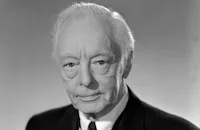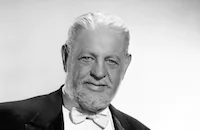Tell It to the Judge
Brief Synopsis
Cast & Crew
Norman Foster
Rosalind Russell
Robert Cummings
Gig Young
Marie Mcdonald
Harry Davenport
Film Details
Technical Specs

Synopsis
When a United States Senate committee that is meeting to decide her appointment to the federal bench questions her about her recent divorce from lawyer Peter Webb, Marsha Meredith argues that she will be a better judge without him. Later, learning that Marsha is in Palm Beach, Florida, Peter travels there, ostensibly to get the testimony of show girl Ginger Simmons in preparation for his defense of small-time gangster George Ellerby. When Marsha sees Peter, whose previous efforts to talk to Ginger were responsible for their divorce, at her hotel, she picks up Alexander Darvac, a shill for a gambling club, and has cocktails and dinner with him. Later, followed by Peter, Darvac takes Marsha gambling. When the club is raided, Peter helps Marsha escape through an old Prohibition tunnel. They land in the water and steal a boat, which they take to a nearby lighthouse. While they hide there waiting for things to cool off, Peter uses the opportunity to persuade Marsha to take him back. After they remarry, Peter and Marsha return to Palm Beach. Afraid that the marriage will ruin Marsha's chances to become a federal judge, her grandfather, Judge Meredith, convinces the couple to hold back the announcement until after the hearing. Back at the hotel, Ginger tells Peter that Ellerby has jumped bail and is downstairs in the bar. Peter accompanies Ginger to the bar, where he is seen by the judge. After Peter accidentally drinks a knockout potion meant for the loudly drunken Ellerby, the judge removes Peter's clothes and puts him on a train. When Peter does not return to their room, Marsha is furious. In the meantime, reporters have gotten wind of her marriage, so Marsha is forced to claim to have married a man named Roogle, who died the night of the wedding. Marsha then leaves for the Adirondacks to stay with her friend, Kitty Lawton, hoping to avoid further publicity. Once he disembarks from the train, Peter follows Marsha and announces that Roogle is still alive and will soon join them. When Darvac unexpectedly appears, Marsha pretends that he is Roogle. To further complicate matters, Ginger also arrives in the mountains, and Peter sneaks her into his room to hide. As a honeymoon surprise, Kitty arranges for Marsha and Darvac to spend the night in a separate house. Afraid of possible scandal, Marsha tries to decline the offer, but then finds Ginger and is so angry that she leaves with Darvac. After they arrive at the house, Marsha sends Darvac to spend the night at a nearby inn. When Peter appears, Marsha lets him believe that Darvac is still in the house. Through a ruse, Marsha slips Peter some sleeping pills, and he is asleep when Darvac returns to announce that the inn is closed for the winter and that he plans on taking his "husbandly" privileges. Marsha then hits him on the head and locks herself in the bedroom. Later, after Marsha gets her federal appointment, she learns what her grandfather did and tells him that she only became a judge to please him. She then returns to Peter and her "job as a wife."

Director

Norman Foster
Cast

Rosalind Russell

Robert Cummings

Gig Young

Marie Mcdonald

Harry Davenport
Fay Baker
Katharine Warren

Douglass Dumbrille

Clem Bevans
Grandon Rhodes

Louise Beavers

Thurston Hall

William Bevan

Steven Geray
William Newell
Polly Bailey
Dorothy Vaughan
Bill Lechner
Edward Emerson

Harlan Warde
Frank Sully
Michael Cisney
Ralph Montgomery
Herbert Vigran

Dooley Wilson
Pat Flaherty

Lee Phelps
John P. Barrett
Franklin Parker
Jessie Arnold
Nicholas Volpe
Boyd Davis
Robert Malcolm
Herbert Evans
Ben Welden
Ted Jordan
Jay Novello
Lester Dorr
Ann Beck

Bess Flowers
Nita Mathews
Hank Patterson
Peter Virgo
Major Sam Harris
Jack Chefe
James Davis
Irmgard Dawson
Crew
Buddy Adler
Carl Anderson
George Cooper
Devery Freeman
Werner R. Heymann
Helen Hunt
Roland Kibbee
William Kiernan
Jean Louis
Charles Nelson
Sam Nelson
Nat Perrin
Fred Phillips
Allan Scott
Morris Stoloff
Joseph Walker

Film Details
Technical Specs

Articles
Tell It to the Judge
Russell herself looked back on these movies with a kind of amused disdain: "I played - I think it was 23 career women. I've been every kind of executive and I've owned everything - factories and advertising agencies and pharmaceutical houses... The script always called for a leading lady somewhere in the 30s, tall, brittle, not too sexy. My wardrobe had a set pattern: a tan suit, a gray suit, a beige suit, and then a negligee for the seventh reel, near the end, when I would admit to my best friend on the telephone what I really wanted was to become a dear little housewife."
In Tell It to the Judge, Russell's ex-husband Robert Cummings tries to win her back, but Russell, an attorney, is initially much more focused on becoming a federal judge. Russell biographer Bernard Dick has written that the actress was not very interested in this picture, and during filming "she went on autopilot, relying on technique alone." He points out, however, that at least she looks quite glamorous in her Jean Louis costumes. As for the ending, Dick writes, "if taken seriously, [it] would have caused women in the professions to abandon their jobs and become homemakers."
"The frightening thing about those pictures," Russell once said, "was that the public loved them, and they all made money." A big irony is that Russell herself managed to have a career and a marriage, both very successful.
Even though the ending is something of a lame product of its time, that doesn't mean that the 99% of the movie up to that point is bad. Jeanine Basinger writes of these Rosalind Russell movies: "They present the battle of the sexes in a way that both men and women can enjoy. Russell puts men down, her anger serving the needs of comedy yet connecting to something real in viewers, but then she repents."
In a supporting role here is actor Gig Young, who had recently left Warner Brothers and taken a couple of freelance assignments for MGM and Republic before signing a contract with Columbia. According to Young's biographer George Eells, Harry Cohn promised him a starring role in The Loves of Carmen (1948) opposite Rita Hayworth if he first played a "weakling husband" in Lust for Gold (1949). Young went along with this, only to find himself eventually forced into the far less glamorous Tell It to the Judge, while Glenn Ford got The Loves of Carmen. "In retaliation," writes Eells, "he went on suspension and eventually broke his contract with Columbia, knowing full well that he risked the insecurity of a finished career."
In fact, three Oscar® nominations for Best Supporting Actor lay in his future, and he would win the award for They Shoot Horses, Don't They? (1969). Marring his life, however, were alcoholism, impotence, four marriages (including one to Elizabeth Montgomery) and ultimately murder; he shot his fourth wife, Kim Schmidt, to death before committing suicide in 1978.
Producer: Buddy Adler
Director: Norman Foster
Screenplay: Nat Perrin, Devery Freeman (story), Roland Kibbee
Cinematography: Joseph Walker
Film Editing: Charles Nelson
Art Direction: Carl Anderson
Music: Werner R. Heymann
Cast: Rosalind Russell (Marsha Meredith), Robert Cummings (Pete Webb), Gig Young (Alexander Darvac), Marie McDonald (Ginger Simmons), Harry Davenport (Judge MacKenzie Meredith), Fay Baker (Valerie Hobson).
BW-87m.
by Jeremy Arnold
Sources:
Jeanine Basinger, A Woman's View: How Hollywood Spoke to Women 1930-1960
Bernard Dick, Forever Mame: The Life of Rosalind Russell
George Eells, Final Gig: The Man Behind the Murder

Tell It to the Judge
Quotes
Trivia
Notes
The film's working title was My Next Husband.














